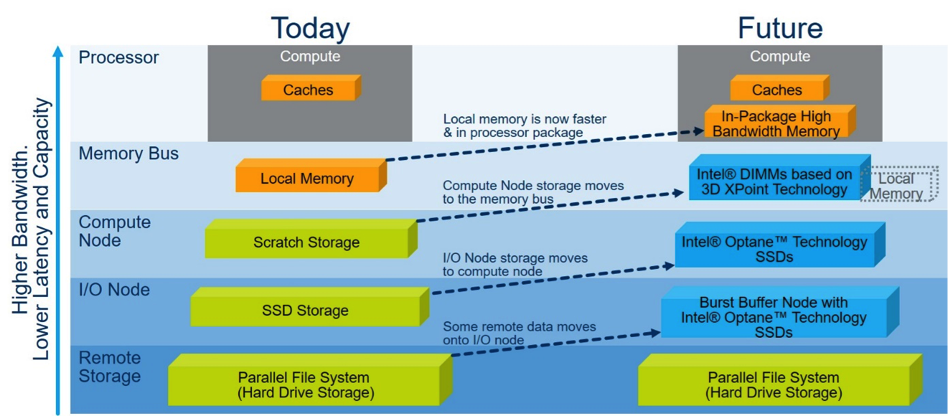By: Ken Strandberg
Watching Intel over the years as they have continually integrated more of PC and server resources into their silicon and provided consistent architecture roadmaps, it’s not surprising that they are now taking that approach on a system level to advance high-performance computing (HPC). At SC15 they announced and demonstrated the Intel® Scalable Systems Framework (or Intel® SSF), which they expect will move HPC toward Exascale computing and make it easier to build balanced, high-performance systems.
We know Intel as a leader in HPC, and as the company with expertise to support integrators with bringing together and optimizing their individual components and software into an HPC system. But Intel SSF is the first time Intel has taken a stance of creating an integrated framework for supercomputers with plans to establish reference architectures for building systems based on the framework.
Another interesting aspect of their new approach is the company’s objective to make HPC more available to more users. The big systems that make the TOP500.org lists are usually built for specific purposes. Intel SSF is designed to make it easier for a wider variety of workloads to run on the same system—scientific codes alongside big data analytics next to visualization, etc.—to essentially spread the HPC love to more departments in an enterprise. If successful, that will mean a huge benefit to companies who want to leverage HPC but can’t afford to build several highly specialized machines for multiple departments.
While the architecture might not offer the highest performance for all workloads, Intel’s philosophy could deliver not only the highest performance for certain workloads, but also provide sufficient performance on other workloads to enable innovation and allow departments to justify their own finely tuned machines in the future, if necessary. We see this same approach in other sectors. Iowa State University, for example, recently installed Condo, a supercomputer funded by multiple departments and built to provide computing to a wider audience of researchers than is possible when a single university school owns the entire resource. If they make HPC easily available to more researchers, more work gets done, potentially leading to greater insights and discovery. The Bridges machine at the Pittsburgh Supercomputing Center was also built for a similar objective.
What is Intel® Scalable System Framework?
Intel SSF integrates existing and next-generations of compute and storage products—Intel® Xeon® processors, Intel® Xeon Phi™ processors and Intel® Solutions for Lustre* software—with some new and innovative technologies. Among the latter is the recently launched Intel® Omni-Path Architecture (Intel® OPA), the recently announced Intel® Optane™ Technology built on 3D Xpoint™ Technology (pronounced 3D cross-point), and Intel® Silicon Photonics.
Intel Omni-Path Architecture, launched at SC15, is an end-to-end complete fabric solution with controllers, network interface cards, cabling, and switches. Intel claims it outperforms InfiniBand EDR*, with up to 17 percent lower MPI latency and 7 percent higher messaging rate than EDR. Central to Intel OPA are power-efficient, 48-port switching chips, which will handle more connections in the same space as current InfiniBand switches. According to Intel, lower power and higher capacity, resulting in fewer switches in the infrastructure, should reduce power and cooling demand up to 60 percent, which is a huge improvement in the datacenter. They also expect that the need for fewer switches will free up budget for 26 percent more compute nodes, making more processing available for discovery.
Intel says that existing applications will run unmodified on Intel OPA if codes were written using the software stack provided by the OpenFabrics Alliance for InfiniBand, called OFED (OpenFabrics Enterprise Distribution).
Integration from the Micro to Macro Levels
Over the years, we’ve seen chip designers continually integrate outboard functions—memory controller, graphics, and massive caches—with the processor. Intel SSF is extending tight integration to the system level. Intel’s architectural strategy brings the rest of the HPC components—memory, I/O and storage—closer to the processing cores to reduce latency and improve efficiency. One of the outcomes to this level of integration is enabling new levels of scalability across the node and system, which essentially raises the center of gravity of the memory pyramid and makes it fatter. Together, the approach enables faster and more efficient data movement, according to Intel.

With Intel SSF, the next generation of supercomputers should prove to be an interesting evolution from both the integrators’ and user’s perspective. Several system builders, including Colfax, Cray, Dell, Fujitsu Systems Europe, HPE, Inspur, Lenovo, Penguin Computing, SGI, Sugon, and Supermicro, have already committed to building machines based on the framework. Aurora, a 180 petaflops machine, being planned for deployment in 2018 at Argonne National Laboratory, will be likely be the largest instantiation of Intel SSF.
Learn more about Intel Scalable Systems Framework
